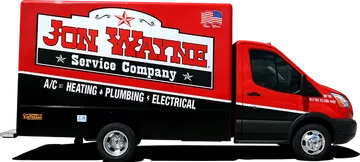How to Flush a Water Heater

Flushing a water heater entails emptying the hot water and removing all the built-up sediment and minerals inside the tank. However, many homeowners forget to have this done regularly. This can impact a water heater's performance and lifespan.
Given how crucial your water heater is to your family's comfort and the smooth operation of your home, it's essential to understand the process. In this guide, we'll look at:
- Why water heaters need to be flushed
- Preparing to flush your water heater
- A step-by-step guide to flushing your water heater
- Reducing buildup in your water heater for long-term efficiency
- When to hire a plumber to flush your water heater
By the end of this article, you'll understand how to get the most value out of your water heater by keeping it running for years to come.
Need Your Water Heater Serviced ASAP? Send for Jon Wayne!
Discover why we've earned thousands of 5-star reviews. Trust Jon Wayne for your tank water heater service and we'll have your system back up and running before you know it. Our service always comes with a 100% satisfaction guarantee.
Why Water Heaters Need to Be Flushed
San Antonio's water supply contains a high concentration of minerals. Over time, these minerals build up inside your water heater's tank alongside sand, rust, and debris from the pipelines.
Because tank contaminants coat the heating element, your water heater ends up consuming more energy during operation. If you don't flush a water heater regularly, you might even suddenly find yourself without hot water due to component failure.
Preparing to Flush Your Water Heater
Wondering how to do a water heater flush? The process can be complicated and is often best left to a professional, but you can potentially do it yourself.
You might need the following tools and materials:
- Screwdrivers and wrenches
- A long hose
- A large bucket
- Gloves and safety goggles
Several safety precautions must also be taken. Start by turning off the power to your electric water heater or switching your gas water heater to pilot mode, which turns off the main burner and leaves only the pilot light on. You'll need to wait several hours for the tank to cool before proceeding further.
Step-by-Step Guide to Flushing Your Water Heater
Ensure everything goes smoothly by following these step-by-step instructions on how to flush your water heater.
1. Check that the Power Is Off
As noted in the previous section, the power needs to be off and your water tank must cool. Double-check the breaker or gas supply before beginning.
2. Drain the Tank
System designs vary, so have your water heater manual handy for reference. To drain the tank, close the cold water inlet valve and attach a hose to the drain valve. Position the other end of the hose outside, in a floor drain, or in a bucket, and turn on the closest hot water tap and open the drain valve.
3. Flush Out the Sediment
Once all the water is drained, open the cold water inlet and add a little more water to lift sediment from the bottom. Drain this, and repeat until it runs clear.
4. Refill the Water Heater
Close the drain valve and remove the hose. Turn the cold water inlet back on. Watch the hot water tap you turned on earlier until any air is expelled and cold water runs out, and turn that tap off. Then, restore power or gas.
Reducing Buildup in Your Water Heater for Long-Term Efficiency
Mineral buildup in a water heater cannot be entirely avoided, but there are things you can do to limit it.
Installing a water softener has the most impact because it removes minerals before they can deposit in the tank. However, lowering your water heater's temperature can help reduce mineral precipitation.
You should also follow a regular maintenance schedule, including flushing annually and replacing your water heater's anode rod every 3–5 years.
When to Hire a Plumber to Flush Your Water Heater
Flushing your water heater regularly is the key to ensuring it has a long lifespan and runs efficiently. However, if you're not comfortable with the process or there's lots of sediment buildup, it's generally best to leave the task to a professional. Professionals can also descale the system for a deeper clean.
Schedule Your Water Heater Flush Today!
Jon Wayne stands for integrity, honesty, and convenience. Need a tank water heater service? We'll get the job done right the first time, saving you time and money.

